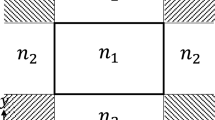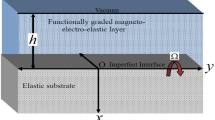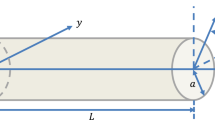Abstract
Overmoded coaxial waveguides have been used in coaxial gyrotrons as a key interaction structure. To achieve the required mode selectivity, the resistivity of the center conductor is properly chosen to damp unwanted modes. Considering attenuation due to conductor loss, this study employs the perturbational method to determine the propagation constants of higher-order modes in the coaxial waveguide. The validity of the theoretical model is confirmed by comparison with results obtained using the high-frequency structure simulator (HFSS). Moreover, the method proposed herein is applied to analyze the ohmic mode selection of the coaxial waveguide.
Similar content being viewed by others
References
1. B. Piosczyk, A. Arnold, G. Dammertz, O. Dumbrajs, M. Kuntze, and M. K. Thumm, “Coaxial cavity gyrotron—recent experimental results,” IEEE Trans. Plasma Sci., vol. 30, pp. 819–827, 2002.
2. O. Dumbrajs, and G. S. Nusinovich, “Coaxial gyrotrons: past, present, and future,” IEEE Trans. Plasma Sci., vol. 32, pp. 934–946, 2004.
3. J.J. Barroso, P. J. Castro, and R. A. Correa, “Geometrical effects in gyrotron coaxial cavities: application to mode selection,” IEEE Trans. Microwave Theory and Tech., vol. 43, pp. 1384–1386, 1995.
4. P.J. Castro, J. J. Barroso, and R. A. Correa, “Ohmic selection in open coaxial resonators: an experimental study,” Int. J. Infrared and Millimeter Waves, vol. 14, pp. 2191–2201, 1993.
5. G. S. Nusinovich, M. E. Read, O. Dumbrajs, and K. E. Kreischer, “Theory of gyrotrons with coaxial resonators,” IEEE Trans. Electron Devices, vol. 41, pp. 433–438, 1994.
6. N. Marcuvitz, Waveguide handbook, McGraw-Hill, New York, 1951.
7. J. D. Jackson, Classical electrodynamics, Wiley, New York, 1990.
8. R. F. Harrington, Time-harmonic electromagnetic fields, McGraw-Hill, New York, 1993.
9. C. L. Hung, and Y. S. Yeh, “Spectral domain analysis of coaxial cavities,” Int. J. Infrared Millimeter Waves, vol. 24 pp. 2025–2041, 2003.
10. Q. S. Wang, D. B. McDermott, and N. C. Luhmann, Jr, “Operation of a stable 200-kW second-harmonic gyro-TWT amplifier,” IEEE Trans. Plasma Sci., vol. 24, pp. 700–706, 1996.
11. K. R. Chu, H. Y. Chen, C. L. Hung, T. S. Chang, L. R. Barnett, S. H. Chen, T. T. Yang, and D. J. Dialetis, “Theory and experiment of ultrahigh-gain gyrotron traveling wave amplifier,” IEEE Trans. Plasma Sci., vol. 27, pp. 391–404, 1999.
Author information
Authors and Affiliations
Rights and permissions
About this article
Cite this article
Hung, CL., Yeh, Y. The Propagation Constants of Higher-Order Modes in Coaxial Waveguides With Finite Conductivity. Int J Infrared Milli Waves 26, 29–39 (2005). https://doi.org/10.1007/s10762-004-2029-2
Received:
Published:
Issue Date:
DOI: https://doi.org/10.1007/s10762-004-2029-2




